Triumph logo
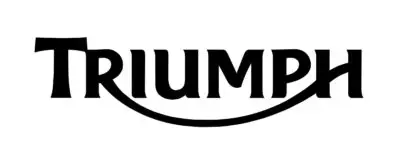
«Triumph» is the youngest and at the same time the oldest British brand. The company was established in 1902 but later stopped working because of several reasons. Manufacturing was successfully resumed in 1991. «Тriumph» produces classic and touring motorcycles, cruisers, roadsters, sport, and vintage models of travel enduro.
| Triumph Info | |
|---|
| Founded | 1885 |
| Founder | Siegfried Bettmann Moritz (Maurice) Schulte |
| Defunct | 1984 |
| Headquarters | Coventry, England |
| Parent | Standard Motors Ltd Leyland Motors Ltd British Leyland Motor Corporation Ltd BMW |
| Official website | www.triumph.co.uk |
Triumph Motorcycle History
The history of the brand is divided into four periods. The first time (from 1885 to 1936) company was run of by its founder Siegfried Bettmann, later (from 1936 to 1973), Edward Turner replaced him and become an executive director. The «Cooperative of workers» was created during a short period «Norton-Villiers-Triumph» (from 1973 to 1984). And finally, in 1990 John Bloor headed the contemporary firm which started its rebirth. «Triumph» started producing machines, comparable to the level of modern technological development.
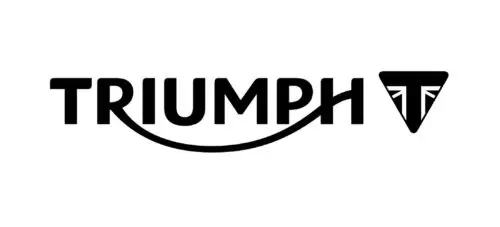
The very first «Triumph» motorcycle was released in 1902. That was a reinforced bicycle frame, equipped with a Belgian engine «Minerva» of 239cm³. It could develop the speed up to 40 km/h. In 1907, a «Triumph» motorcyclist Jack Marshall racing for the first time at the competition on the Isle of Man took 2nd place in the class of single-cylinder machines. That was a great breakthrough for the company.
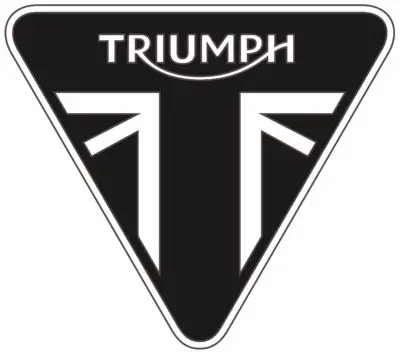
In 1922, the fresh «Toure IR Fast Roadster» which also called «Riccy» was released with an engine capacity of 499 cm/cc and a new «Triumph» logo. And in 1937, Edward Turner’s «Speed Twin» model shocked the world by its ability to develop speeds up to 150 km / h. In 1939, the firm created a silver «Tiger 100» which is considered to be a sports analog for «Speed Twin». And in 1959, the new model «T120 Bonneville» was presented at the London Earls Court exhibition, and that was a real furor.
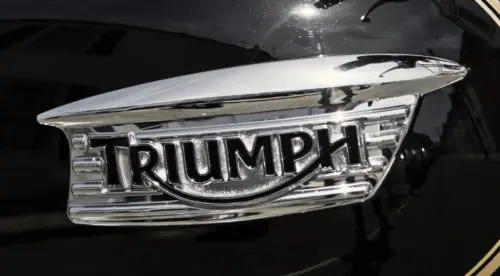
In September 1990, in Cologne, the world saw a new collection of motorcycles: «Trophy», «Daytona», and «Trident». In 1994 company reproduced the «Thunderbird» retro pattern. Nowadays, «Triumph» is a very successful company which produces both modern and retro motorbikes. Despite its long history and especially the periods of «ups» and «downs» the demand for its goods is still high.
Triumph Logo History
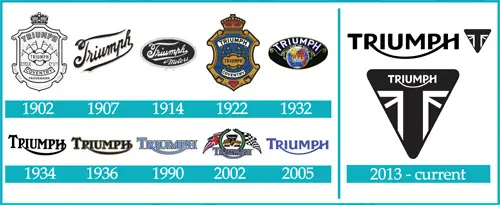
The history of Triumph Motorcycles Limited Company began in 1885, when German immigrants, Siegfried Bettmann and Maurits Schulte, bought a company in Great Britain which started the production of bicycles under the Triumph brand.
Before that Siegfried Bettmann had already got some experience in selling bicycles: this form of transport was becoming more and more popular in England then, and he organized sales of bicycles manufactured by the Birmingham manufacturer William Andrews. After a rapid increase in sales and a meeting with Mauritius Schulte, Siegfried decided to set up his own manufacture.
The ancestors of motorcycles were bicycles with motors that were released under the Triumph brand.
| 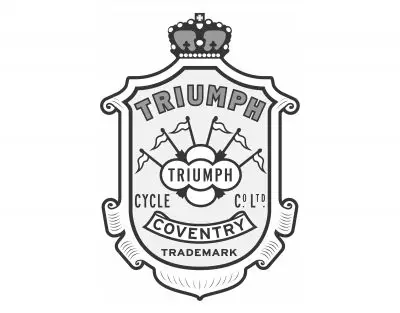 In 1902, a 'first-born' appeared, which, without thinking twice, was named No.1. And it was on this motorcycle that the first Triumph logo appeared - 'Shield' (then the name of the company was official: Triumph Cycle Co. Ltd.). The emblem was made in the form of a shield on top of which was a crown. The logo had the name of the company at that time: Triumph Cycle Co. Ltd., and a tape with the name of the city (Coventry), where the company's production facilities were located. The inscription 'Trade Mark' on the Triumph logo meant that the brand was officially registered. The logo also had 6 flags, the meaning of which is not mentioned anywhere and is not known. |
| 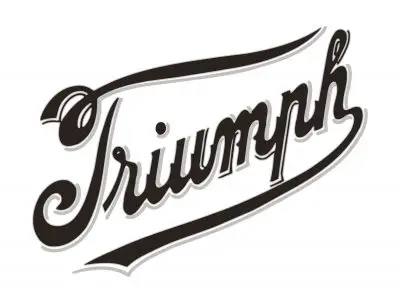 Before 1907, there had been several changes in the name of the company, the final one being Triumph Engineering Co. Ltd. Changes of the name of the company did not affect the sales of products. In 1907, the company's capacity produced up to 1,000 motorcycle units per year, there was an expansion of the plant's capacities, and then a new Triumph Script logo appeared. It had absolutely nothing in common with the old emblem. The new logo was the name of the company written in an oblique calligraphic font. |
| 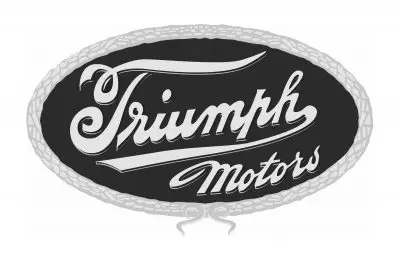 In 1914, the Triumph Script logo was updated. The First World War began, and the company switched to the production of motorcycles for the needs of the government. Then for better recognition, the Triumph Script logo was made in an oval, the rim of which was made similar to a braided rope. And the inscription Motors appeared under it. This logo appeared on the manufactured products, until the end of the 1920s. |
| 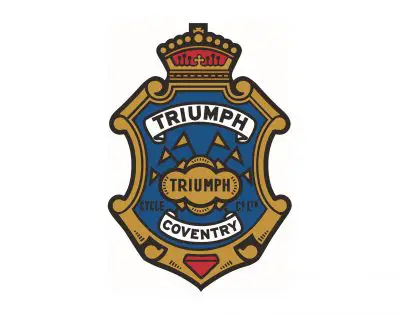 In the early 1920s, a new change of the logo took place. That time it was a return to the past, namely to the Shield form. The very form of the Shield was slightly modified. The crown over the shield was also changed, it became bright and clear. There was almost no change inside the Triumph logo in comparison with the logo of 1920. |
| 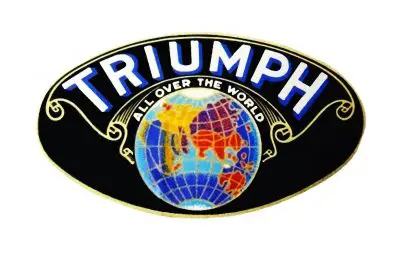 In 1928 the company began production of cars. The products of the company gained popularity worldwide, and it became apparent that the company's revenue from export was higher than domestic sales. Probably in consequence of this, in 1932, a logo with the words ‘Triumph All over the World’ appeared, and it is known among the fans as the Globe Triumph. The shape of the logo was oval, the globe was placed in the middle of it, and there was the name of the Triumph Company above it in a frame of curls. The slogan ‘Triumph All over the World’ was between them. 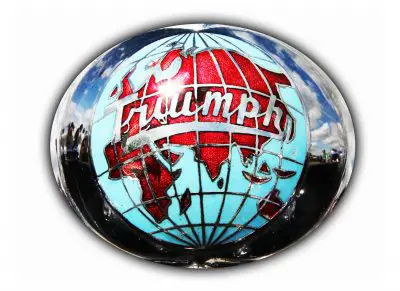 There was a half of the globe with printed inscription "Triumph" on the motor hoods of the cars of that time. |
| 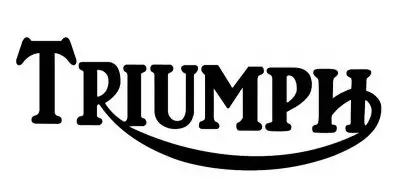 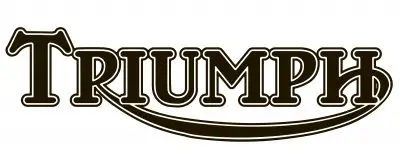 Car enthusiasm played a low-down trick on the direction of motorcycle production: it gradually fell into decay, short of financing. On January 22, 1936, motorcycle production was sold to John Yang Sangster, who owned the factory for the production of Ariel motorcycles, which had won the reputation of reliable and quality ones. The best engineers of the parent company started working on Triumph motorcycles. The logo changed again in 1934. Now there were no shields, no ovals. There was an ordinary simple inscription 'Triumph' made in capital letters, where the line emanating from the letter 'R' smoothly merged into the middle line of the last letter 'H', on the right side. After buying the company by Ariel, the logo also underwent changes. The line had a shorter stroke, and it slightly passed under the letter 'I'. The font itself became bolder, heavier, and found a contour. This logo was known right up to 1990. |
| 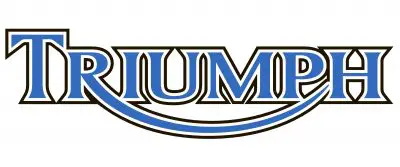 In 1983 the plant of the company was closed, and there were rumors that the brand would soon cease to exist. However, its passionate fan John Bloor invested a lot of money to save his beloved motorcycle manufacturer from bankruptcy. He built a new plant in Hinckley and organized design work to create a new series of motorcycles. In 1990, at the exhibition in Cologne, the Triumph brand introduced a series of new models with the new flagship Trophy 1200 where the new logo of the company was shown. The new owners decided not to move away from the previous logo, so only the font of the inscription was changed. Now it was an acute-angled font, the line emanating from the letter 'R' also smoothly merged into the middle line of 'H', but already on the left side, without touching the letters between them. |
| 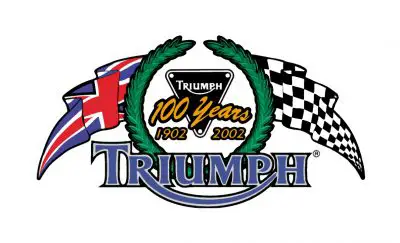 In 2002, the anniversary Triumph logo appeared. It celebrated exactly 100 years from the date of release of the first motorcycle of the company. |
|  In 2005, the logo lost its contour. The same angular slightly modified font remained, but its readability and clarity increased. |
|  In 2013 a new logo of Triumph with rounded corners appeared. The font transformed from completely angular to the one with rounded corners on one side. This logo design was developed with the help of London office of Wolff Olins with typographic assistance by Rick Banks. 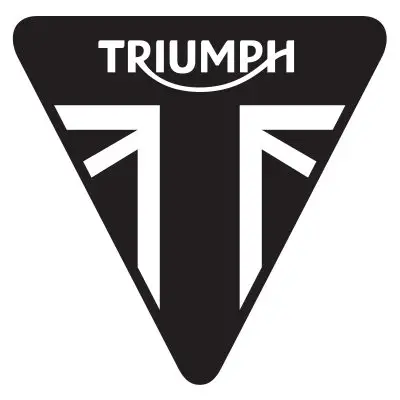 There also appeared a version of the logo in the form of a triangle turned upside down, and the edges of which are drawn like "mechanical wings". There may be an inscription ‘Triumph’ in the middle, depending on where the logo is to be used. |
Meaning Triumph Logo
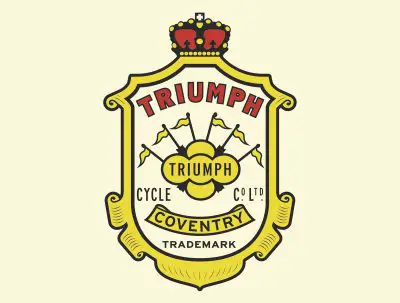
Bettman kept thinking under what name to sell the bicycles because his own name was not loud enough to promote the product. He knew three languages (German, English, and French), and then the word Triumph, which sounds similar and has only one meaning in many languages, came to his mind.
Emblem Triumph
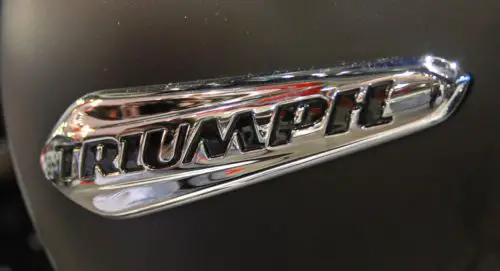
The official logotype is a black-colored description in Latin on the white background. This variant was actually from 2011 to 2013. But in 2013, the emblem was decided to be modified. Designers slightly rounded the logo’s corners.
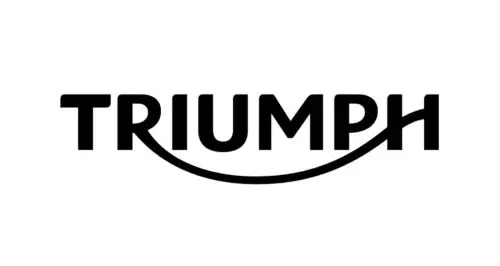
There is one more emblem, used for motorbikes and related products — the inscription enclosed in a triangle.





















